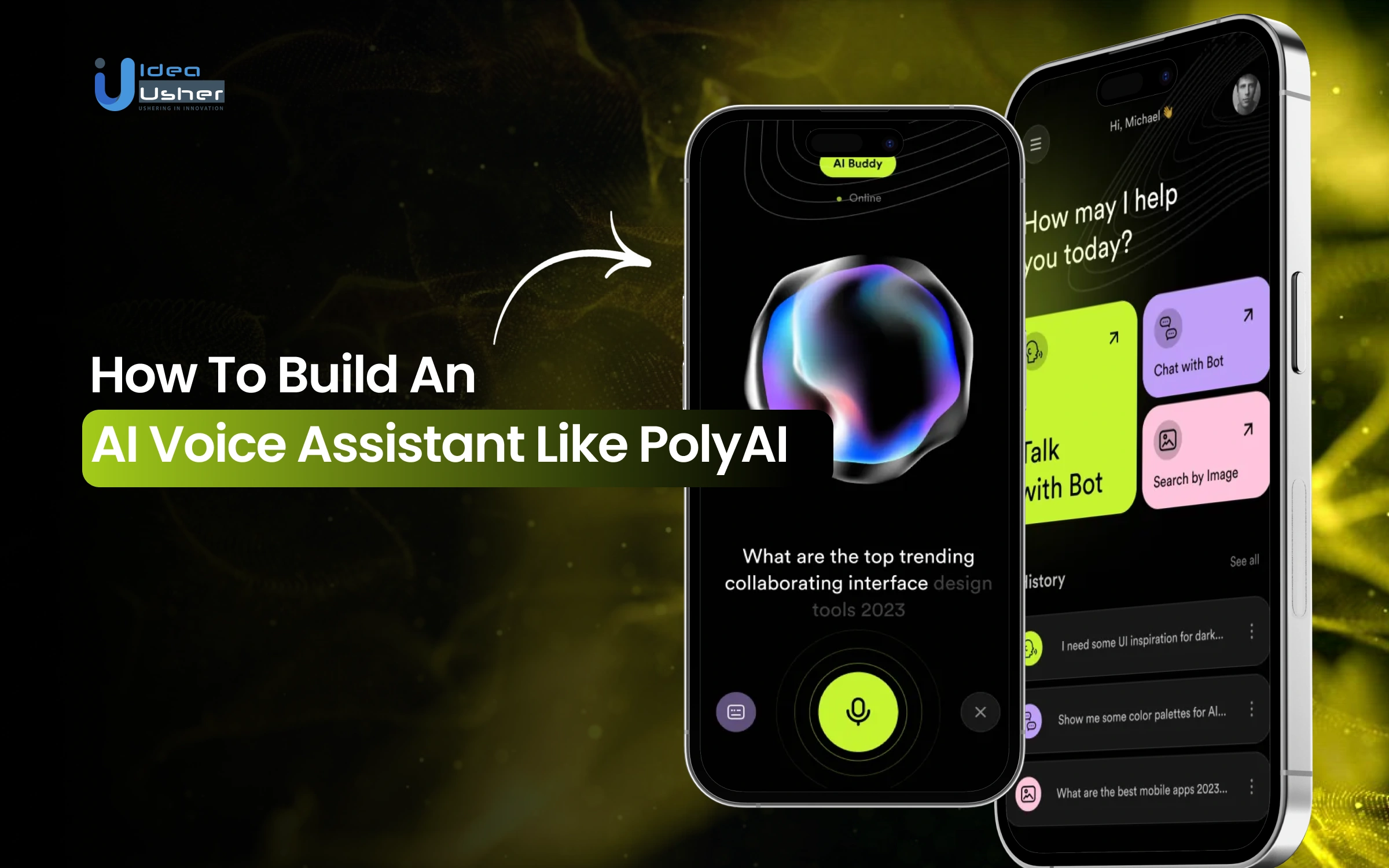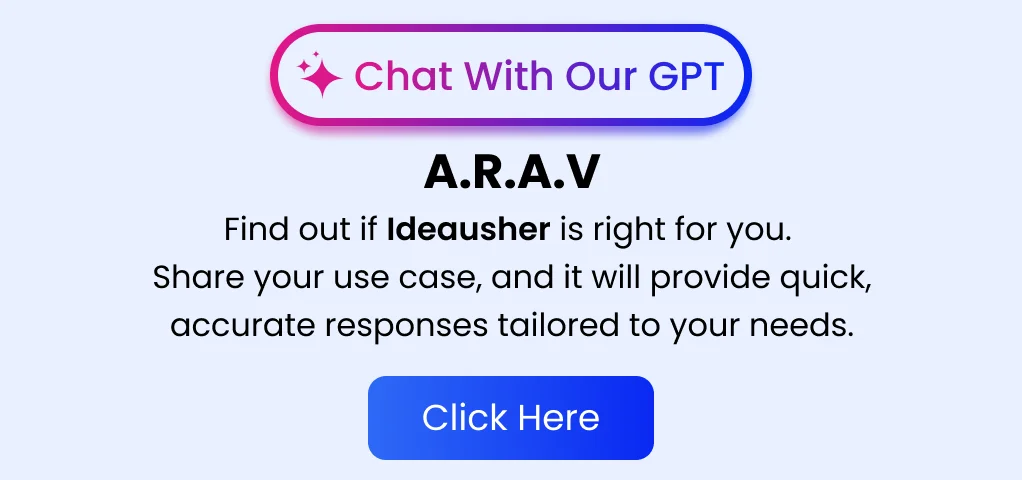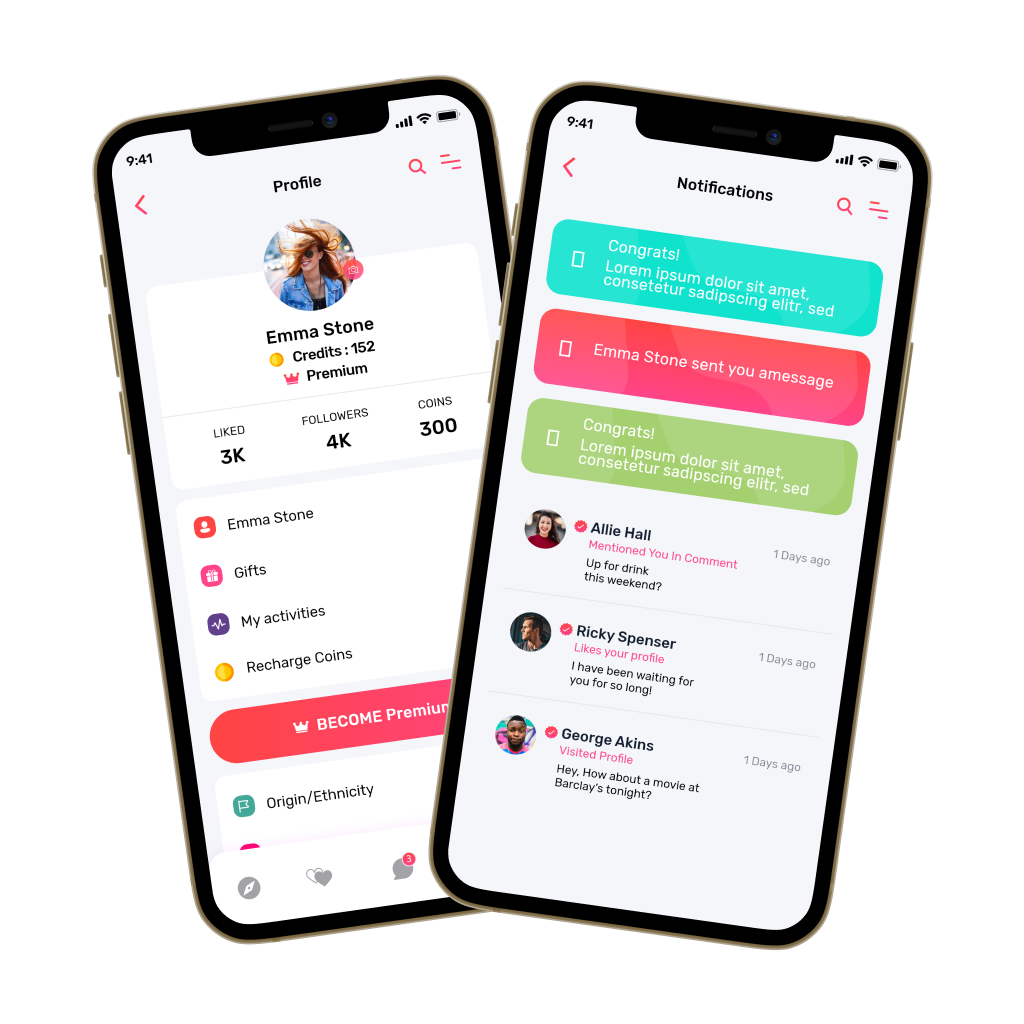Customers today are tired of waiting on hold or dealing with long, confusing chat menus. They want quick, natural responses, and that’s exactly what the AI Voice Assistant offers. Using natural language processing and real-time learning, it is changing the way brands connect with and support their customers.
This shift is driven by a mix of natural language understanding, speech synthesis, and real-time personalization, which platforms like PolyAI have mastered. Their skill in creating smooth, context-aware conversations has made voice technology both efficient and emotionally intelligent. This progress has caught the attention of both startups and larger companies.
In this blog, we’ll explore how you can build a powerful AI voice assistant like PolyAI, breaking down its key features, tech stack, and development process. As we have helped numerous businesses launch their AI solutions, IdeaUsher has the expertise to help you turn your conversational idea into a scalable, production-ready solution.

What is an AI Voice Assistant, PolyAI?
PolyAI is a British technology company founded in 2017 by Nikola Mrkšić, Tsung-Hsien Wen, and Pei-Hao Su, who met at the Machine Intelligence Lab at the University of Cambridge.
The company specializes in developing voice-first conversational artificial intelligence systems, primarily designed for enterprise customer service. In simple terms, PolyAI’s technology enables automated voice assistants that can answer customer calls and hold natural, human-like conversations.
Unlike traditional text-based chatbots, PolyAI focuses on voice interactions, aiming to automate and improve phone-based customer service experiences. Its advanced voice assistants are designed with several key capabilities, including:
- Natural conversation: PolyAI’s voice assistants can handle interruptions, topic changes, and different ways people speak (accents, dialects, background noise).
- Multi-language & large scale: It supports dozens of languages and is designed for large enterprise call volumes.
- Integration with existing systems: Works with contact-center technology (telephony, CCaaS platforms, CRM systems) rather than replacing everything.
- Transactional tasks: Beyond answering queries, the assistants can verify identity, take bookings/reservations, manage payments, route calls, etc.
- Analytics & optimisation: Captures data from conversations to identify trends, improve the system, and inform business decisions.
Business Model
PolyAI is a conversational AI company providing voice-first automation for large organizations with high call volumes. It combines AI, enterprise integration, and service optimization to enhance customer experience and reduce costs.
- Enterprise customer focus: Targets large enterprises with high-volume inbound voice-call operations in industries such as banking, hospitality, utilities, and logistics.
- Voice-first platform: Offers a conversational AI platform that replaces or augments human agents for inbound calls.
- Comprehensive solution: Combines speech recognition, dialog management, and voice synthesis with integration into telephony, call routing, CRM, and back-office systems.
- Service delivery model: Provides deployment services, pre-built templates for common use cases, multilingual support, and branded voice personas.
- Value proposition: Enables significant cost savings by reducing human-agent volumes while improving customer experience through faster resolution and higher availability.
Revenue Model
PolyAI generates revenue through a combination of usage-based pricing, enterprise subscriptions, and service-related fees. Its model aligns directly with enterprise-scale deployments, emphasizing both cost reduction and revenue generation for clients.
- Usage-based pricing: Charges clients per minute of calling time handled by the voice assistant, tying revenue directly to usage and customer activity levels.
- Subscription/platform license: Likely includes recurring fees for access to the voice assistant platform, ongoing support, and analytics services.
- Implementation & integration services: Earns additional revenue from deployment, customization (e.g., branded voice personas, language support), and enterprise system integrations.
- Value-added revenue capture: Demonstrates measurable client revenue gains through increased bookings, captured missed calls, and higher conversion rates.
- Enterprise contracts: Engages in multi-year agreements with large enterprises, supporting recurring and expanding revenue streams.
Key Financial Metrics & Indicators
In May 2024, PolyAI raised US$50 million in a Series C funding round. That round valued the company at close to US$500 million. With this raise, the company’s total funding to date exceeds US$120 million. Key investors in the Series C included: Hedosophia, NVentures (the VC arm of NVIDIA), Khosla Ventures, Point72 Ventures, Georgian, Sands Capital and Passion Capital.
How PolyAI Helps As an AI Voice Assistant?
PolyAI’s voice assistant is a voice-first AI that manages customer calls, automates tasks, and integrates with enterprise systems using speech recognition, natural language understanding, and dialog management for human-like conversations.
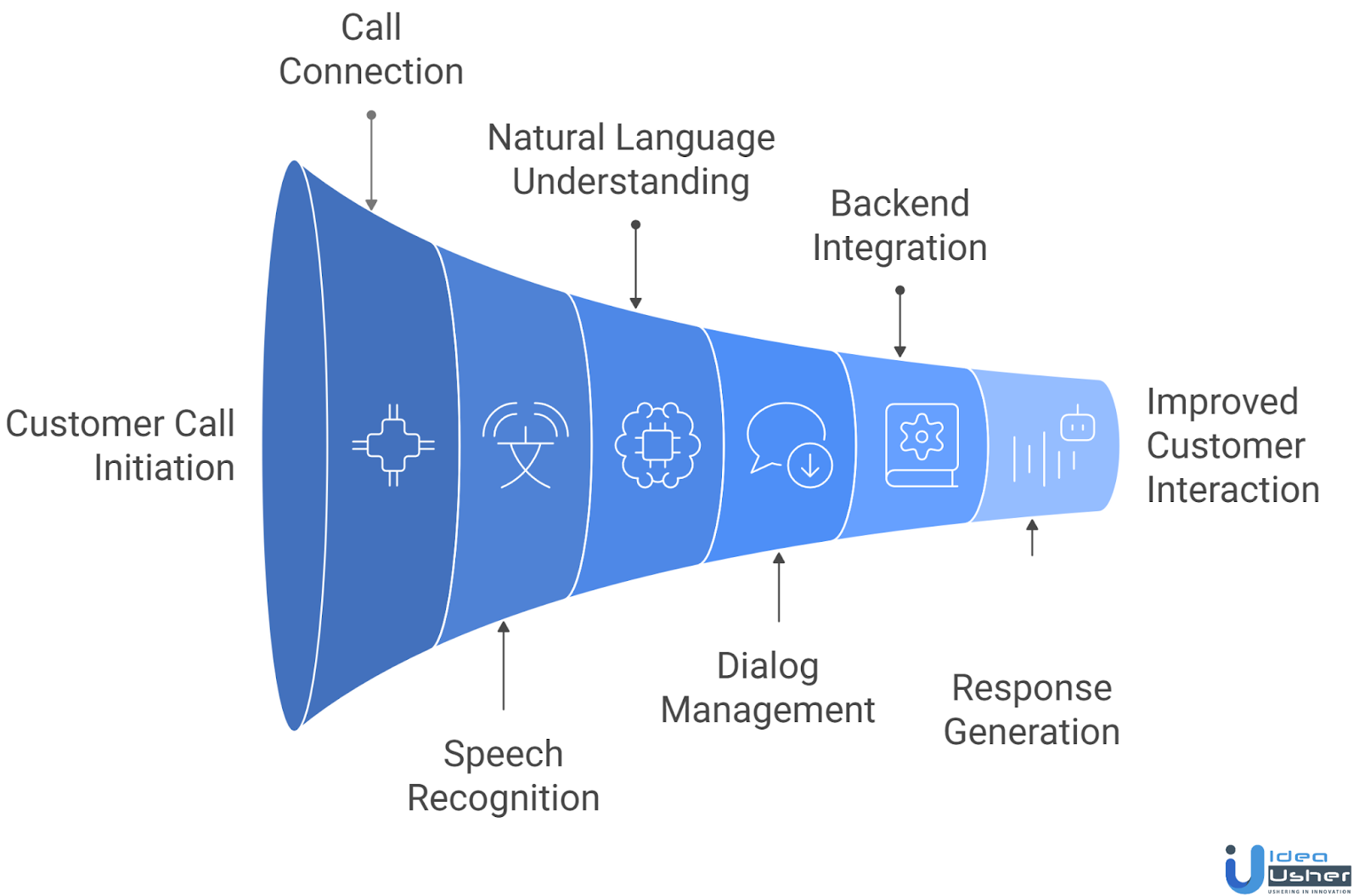
1. Call Initiation & Connection
The process begins when a customer contacts the enterprise through a phone call.
- The call is routed through the company’s telephony or contact center infrastructure to PolyAI’s platform.
- PolyAI connects via APIs or SIP trunking to integrate smoothly with existing systems like Avaya, Genesys, or Twilio.
- Once connected, the assistant is ready to engage with the caller in real time
2. Speech Recognition (ASR – Automatic Speech Recognition)
PolyAI first listens and accurately converts speech into text.
- The assistant uses advanced ASR models trained for enterprise-specific terms and natural variations in speech.
- It recognizes multiple accents, dialects, and languages, making it globally scalable.
- The transcription happens in milliseconds to maintain real-time responsiveness.
3. Natural Language Understanding (NLU)
The system interprets the meaning and intent behind what the caller says.
- PolyAI’s NLU engine analyzes the transcribed text to determine intent (e.g., booking, inquiry, complaint).
- It extracts key entities like names, times, or order numbers to support the conversation.
- The models are continuously fine-tuned using real call data for domain-specific accuracy.
4. Dialog Management & Context Handling
This layer controls the flow and logic of the conversation.
- The dialog manager decides how the assistant should respond or what information it should request next.
- It keeps track of context, allowing the conversation to feel natural and coherent across multiple turns.
- The assistant handles interruptions, clarifications, and topic changes just like a human agent.
5. Integration with Backend Systems
PolyAI connects directly to enterprise systems to perform real actions.
- The assistant accesses CRMs, reservation tools, or databases to fetch or update customer information.
- Example: In hospitality, it can book rooms; in banking, it can verify identity or check balances.
- This integration enables true automation, completing end-to-end customer requests without human input.
6. Response Generation & Voice Synthesis
After processing, the assistant replies in a natural, branded voice.
- Using Text-to-Speech (TTS), it generates smooth, human-like responses.
- Brands can choose custom voice personas that reflect their tone and identity.
- Low-latency TTS ensures that the conversation feels instant and lifelike.
7. Analytics
PolyAI continuously learns and improves from every interaction.
- The system tracks call success rates, durations, and customer outcomes.
- Enterprises use dashboards and analytics tools to optimize scripts and call flows.
- Feedback data retrains ASR and NLU models, leading to smarter and more efficient assistants over time.

How AI Voice Assistants Drive Growth for 82% of Businesses?
The global intelligent virtual assistant market was USD 16.08 billion in 2023, growing to USD 20.21 billion in 2024, and projected to reach USD 178.80 billion by 2034 with a 24% CAGR. This growth is driven by advancements in AI and NLP and increased use in customer service, healthcare, and smart devices.
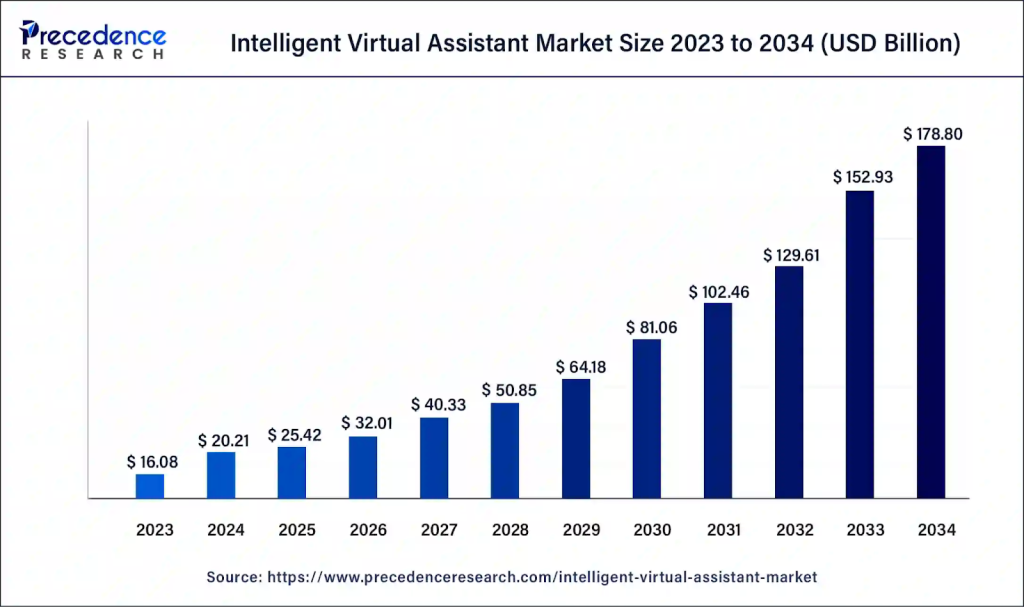
According to the Deepgram State of Voice Report, 82% of companies are already utilizing voice technology, while 85% expect widespread deployment within the next five years. Additionally, 66% of business leaders consider voice-enabled experiences a central part of their future strategies.
Adoption Trends and User Behavior
As of 2024, there were 8.4 billion voice assistant devices globally, more than the world’s population. Despite this, daily engagement is moderate: only 20.5% of internet users perform voice searches regularly, with 91% of interactions on smartphones.
In the U.S., 153.5 million people used a voice assistant in 2025, a number expected to climb to 157.1 million by 2026. Among users, Google Assistant (92M) and Siri (86.5M) dominate the ecosystem.
The gap between awareness and consistent use points to two main user concerns: privacy and trust. These issues still affect how people engage and whether they choose to make transactions.
Business Outcomes and ROI
Voice assistants have evolved into measurable growth engines for enterprises. Businesses deploying AI voice technology report 25–35% improvements in customer satisfaction (CSAT) within three months, largely due to faster response times and 24/7 availability.
In banking and finance, institutions like Bank of America (Erica) and U.S. Bank have reported up to 78% reductions in per-interaction operational costs and substantially shorter customer wait times.
Retail and eCommerce sectors show similar benefits. Automated assistants now handle up to 90% of inbound queries, helping brands achieve a 40% rise in CSAT scores and a 30% reduction in repetitive support tickets.
Furthermore, AI recruiting assistants in HR have improved scheduled interview show rates by 20% and job offer acceptance rates by 18%, proving that conversational AI extends well beyond customer service.
Industry Applications and Real-World Impact
- Manufacturing: Hands-free, voice-activated systems reduced production downtime by 45%, saving one global corporation $8.5 million annually.
- Professional Services: Voice-enabled workflows accelerated project setup by 50% and generated $12 million in additional billable hours.
- Healthcare: Voice assistants cut documentation time by 30%, improved patient satisfaction by 25%, and reduced medical errors by 40%.
- Hospitality & Retail: Smart voice AI systems manage bookings, order-taking, and feedback collection, driving 40% higher customer satisfaction and faster query resolution.
- Insurance & Telecom: Voice bots streamline claims, policy inquiries, and troubleshooting, improving first-contact resolution rates by 80% and minimizing operational strain.
These case studies show voice technology helps companies scale, personalize, and reach diverse customers globally. AI voice assistants have shifted from novelty to necessity, delivering results, redefining engagement, and boosting productivity. Future growth depends on building trust, adding context, and integrating smoothly into daily workflows.
Key Features of an AI Voice Assistant Like PolyAI
An AI voice assistant like PolyAI delivers natural, human-like conversations that enhance customer experience and operational efficiency. By combining advanced speech recognition and intelligent automation, it enables businesses to provide always-on, scalable customer support.
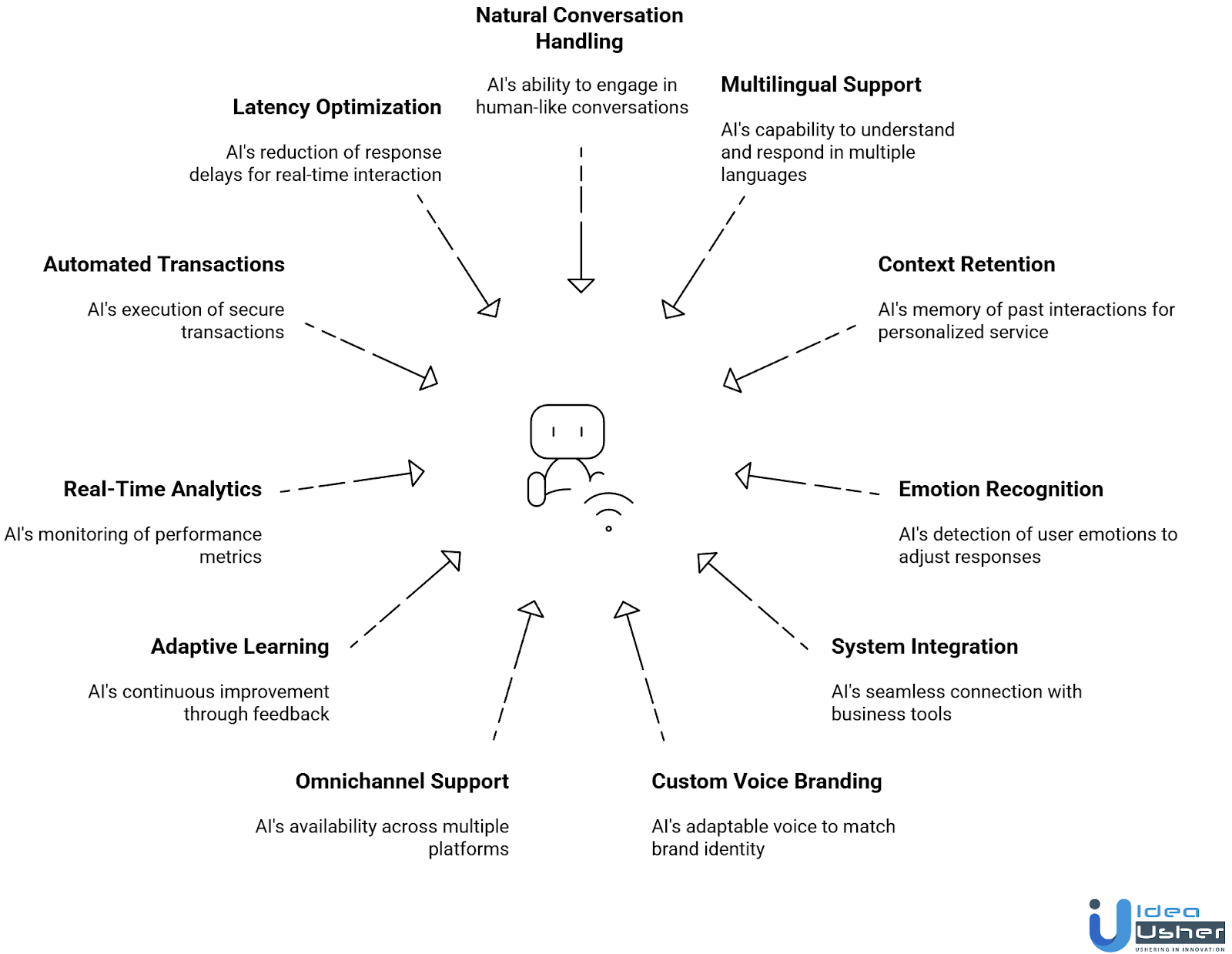
1. Natural Conversation Handling
AI voice assistants like PolyAI use advanced Natural Language Understanding (NLU) to have conversations that feel more human. They can handle interruptions, switch topics, and answer follow-up questions in a natural way. This helps the conversation flow smoothly instead of feeling stiff or scripted.
2. Multilingual & Accent-Aware Support
The AI engine can recognize and respond in multiple languages and dialects, ensuring inclusivity and global reach. It also adapts to diverse accents and speech variations, improving accessibility for users across regions.
3. Context Retention & Memory
The assistant keeps track of your past interactions and preferences, so each conversation feels more personal. This way, you can simply say things like, “Book the same hotel as last time,” without repeating all the details.
4. Voice Emotion Recognition
The assistant adjusts its responses dynamically by analyzing tone, pitch, and sentiment. It can detect user emotions like frustration or happiness and modify tone or pacing to maintain a natural, empathetic flow.
5. Seamless System Integration
PolyAI-style assistants integrate smoothly with CRM, ERP, and ticketing tools, enabling businesses to automate workflows and fetch real-time data during calls. This ensures users can check order status, reschedule appointments, or verify identity without human intervention.
6. Custom Voice Branding
Businesses can adjust the assistant’s voice, tone, and speaking style to fit their brand identity. Whether they want a warm, welcoming sound or a more formal approach, each interaction helps build brand personality and customer trust.
7. Omnichannel Voice Support
AI voice assistants are used in more than just call centers. They also work on websites, mobile apps, IVRs, and smart devices. This means customers get the same quality of service no matter how they reach out.
8. Adaptive Learning & Model Fine-Tuning
Through feedback loops and post-interaction analytics, the assistant continuously learns and fine-tunes itself. This improves response accuracy, context handling, and task success rates over time.
9. Real-Time Analytics & Monitoring
Dashboards and analytics tools track key metrics like average handling time, user sentiment, and conversation outcomes. These insights help teams identify improvement areas and optimize the assistant’s performance for business ROI.
10. Automated Transactional Handling
The assistant can independently execute actions like booking, payment processing, and verification through secure APIs. This not only saves operational time but also enhances customer satisfaction with faster query resolution.
11. Latency Optimization & Edge Processing
AI voice assistants use low-latency infrastructure and edge computing to help conversations flow naturally. This setup reduces response delays, so speech feels real-time and human, even during complex back-and-forth exchanges.

Development Process of an AI Voice Assistant Like PolyAI
At IdeaUsher, we build scalable AI voice assistants like PolyAI using advanced conversational design, NLP, and enterprise integrations. Our developers focus on delivering natural, human-like, and business-ready voice interactions.
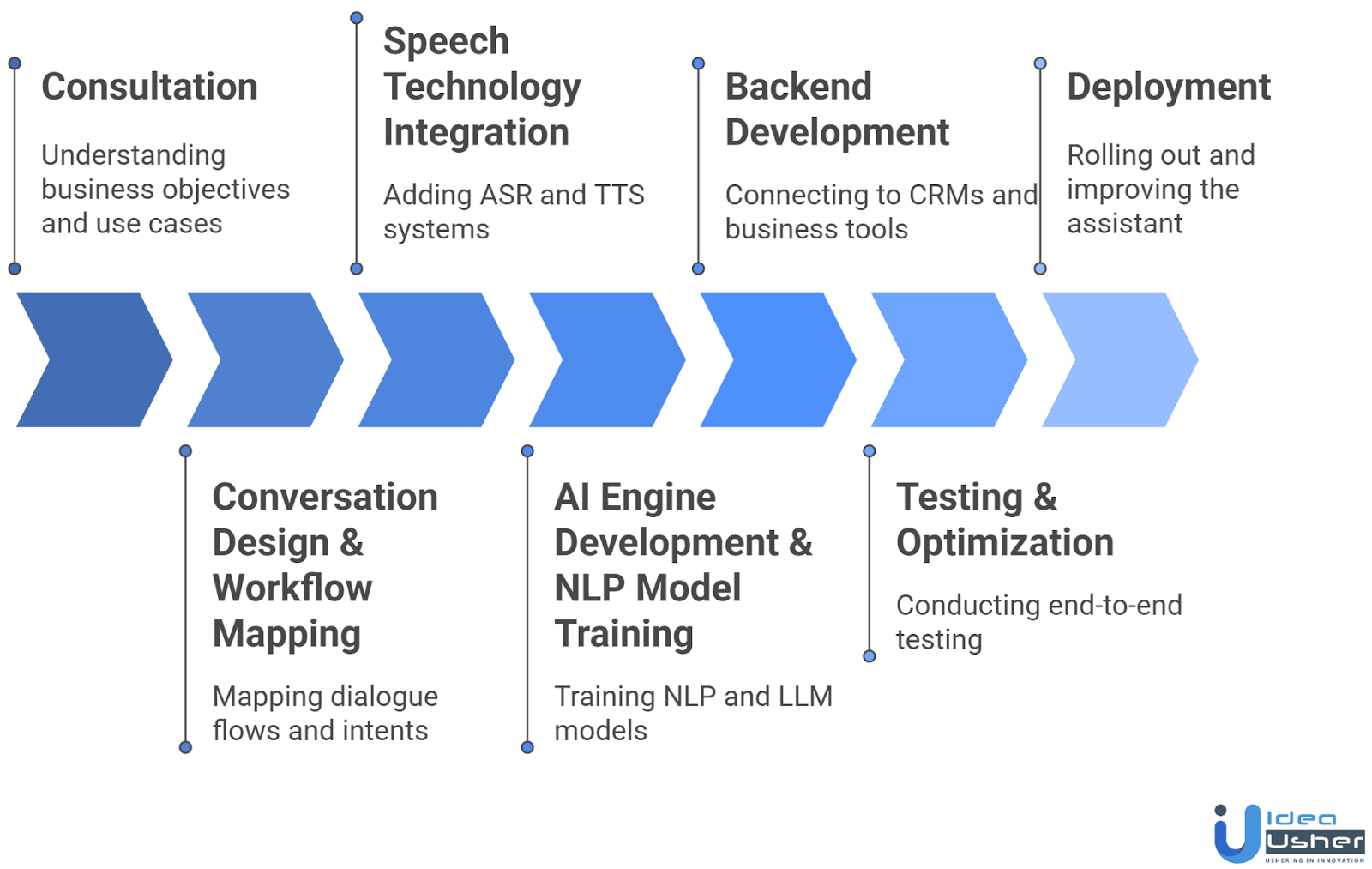
1. Consultation
We start by understanding the business objectives and primary use cases for the voice assistant. Whether it’s automating customer support, handling bookings, or driving sales, our team defines the user journey, success metrics, and communication tone that shape the assistant’s foundation.
2. Conversation Design & Workflow Mapping
Our conversation designers map out dialogue flows, intents, and fallback scenarios to ensure seamless, human-like engagement. We carefully script responses, voice tone, and personality traits so that the assistant aligns perfectly with the client’s brand identity and customer expectations.
3. Voice Interface & Speech Technology Integration
Next, our developers add Automatic Speech Recognition (ASR) and Text-to-Speech (TTS) systems. We adjust voice models to fit the needed style, such as clear, empathetic, or professional, and carefully set up speech and noise controls to make the user experience smooth.
4. AI Engine Development & NLP Model Training
This is where the intelligence comes together. We train Natural Language Processing (NLP) models and Large Language Models (LLMs) using datasets tailored to your field. Our team makes sure the assistant understands intent, sentiment, and context accurately, so it can respond in a natural and relevant way.
5. Backend Integration & API Connectivity
We connect the assistant to your existing CRMs, knowledge bases, and business tools using secure APIs. This setup lets the system fetch real-time data, process transactions, and update records. As a result, the assistant does more than just answer questions; it can take meaningful actions for your team.
6. Testing & Optimization
Before deployment, we conduct end-to-end testing across multiple languages, accents, and use cases. Our QA team evaluates response accuracy, latency, and engagement quality, while continuous feedback loops help fine-tune the assistant for better context recall and response precision.
7. Deployment & Continuous Learning
Finally, we roll out the AI voice assistant on all platforms, including web, mobile apps, contact centers, and IVR systems. After launch, our models keep learning from real interactions, adjusting to new questions, improving tone, and making users happier over time.
Cost to Build an AI Voice Assistant Like PolyAI
Developing a conversational AI voice assistant requires strong speech recognition, NLP capabilities, voice experience design, and continuous machine learning improvements. Below is a clear cost breakdown to help you plan the investment efficiently.
| Development Phase | Description | Estimated Cost |
| Consultation | Defining core features, conversational goals, user segments, and technical scope. | $5,000 – $8,000 |
| Workflow Mapping | Designing intents, conversational flows, context handling, persona, and dialog structures. | $10,000 – $18,000 |
| Voice Interface & Speech Technology Integration | Integrating ASR and TTS engines for multilingual and natural voice interactions. | $12,000 – $22,000 |
| AI Engine Development | Training domain-specific NLP models for context-aware understanding and response accuracy. | $18,000 – $28,000 |
| Backend Development | Integrating CRM, knowledge bases, telephony, databases, and external services. | $10,000 – $20,000 |
| Testing | Voice accuracy testing, latency optimization, stress testing, and security enhancements. | $8,000 – $18,000 |
| Deployment | Cloud setup, production rollout, model monitoring, ongoing improvements, and scalability expansion. | $7,000 – $18,000 |
Total Estimated Cost: $65,000 – $132,000
Note: These investment ranges enable a scalable AI voice assistant with strong NLP, smooth interactions, and enterprise-grade performance. Costs vary with feature complexity, integrations, and model sophistication.
Consult with IdeaUsher to get a customized estimate tailored to your product vision and business goals.
Recommended Tech Stack for AI Voice Assistant Platform Development
Building an AI Voice Assistant Platform needs a scalable, intelligent tech stack for speech recognition, natural language understanding, and real-time responses. Here’s a breakdown of recommended technologies.
1. Speech Recognition (ASR – Automatic Speech Recognition)
To accurately convert spoken words into text, a powerful and adaptive speech recognition engine forms the foundation of any voice assistant platform.
- Frameworks & APIs: Google Speech-to-Text, Whisper by OpenAI, DeepSpeech, Kaldi
- Languages & Libraries: Python, TensorFlow, PyTorch, Hugging Face Transformers
- Enhancements: Acoustic modeling, noise filtering, and real-time speech adaptation
2. Natural Language Processing (NLP) & Understanding (NLU)
This layer enables the assistant to interpret meaning, detect user intent, and respond intelligently by processing the converted text.
- Core Models: GPT, BERT, PaLM, LLaMA, or custom transformer-based architectures
- Libraries: spaCy, NLTK, Hugging Face, Rasa NLU
- Capabilities: Intent detection, context tracking, sentiment analysis, and entity extraction
3. Voice Synthesis (TTS – Text-to-Speech)
Text-to-speech engines transform text-based responses into natural, human-like audio output, creating a smooth conversational experience.
- Engines: Amazon Polly, Google WaveNet, Microsoft Azure TTS, Coqui TTS
- Features: Natural intonation, multilingual voice modeling, customizable tone and emotion
- Output Optimization: Dynamic pitch modulation and speech prosody
4. Backend Infrastructure & APIs
The backend is the operational core, managing logic, data flow, and communication between the voice assistant and connected systems.
- Languages: Python, Node.js, Go
- Frameworks: FastAPI, Flask, Express.js
- APIs: RESTful and GraphQL-based microservices for modular scalability
- Tools: Redis for caching, Kafka or RabbitMQ for event streaming
5. Continuous Model Training & MLOps
Automation in model training and deployment ensures the AI system remains adaptive, efficient, and continuously optimized.
- Pipelines: MLflow, Kubeflow, Airflow for automation
- Versioning & Monitoring: DVC (Data Version Control), Prometheus, Grafana
- Deployment: CI/CD pipelines using Jenkins or GitHub Actions for seamless updates

Challenges & How to Overcome Those?
Developing an AI Voice Assistant Platform goes beyond integrating speech recognition and NLP models; it aims to create seamless, human-like interactions that understand intent, context, and emotion, ensuring reliability security. Below are the key challenges faced during development and practical solutions to overcome them effectively.
1. Speech Recognition Accuracy
Challenge: Voice assistants struggle with regional accents, speech variations, and background noise, causing misinterpretations, frustration, and less trust, especially in multilingual or noisy settings.
Solution: We address this by using advanced ASR models trained on diverse, multilingual datasets. Retraining with real-world voice data improves accuracy, and noise-cancellation algorithms and acoustic modeling enhance understanding in various audio conditions.
2. Context Awareness & Natural Conversations
Challenge: Many voice assistants fail to maintain conversational flow or understand user intent in context, often producing robotic, repetitive, or irrelevant responses that break the sense of natural interaction.
Solution: We use transformer-based NLP models and AI architectures that track history, learn user preferences, and adjust responses. Combining memory layers with intent detection, our platform offers personalized, fluid, and human-like dialogues in real time.
3. Latency & Response Time
Challenge: High response time and processing delays create unnatural communication gaps, making users feel disconnected and reducing the overall usability of the voice assistant.
Solution: We use low-latency cloud and edge computing to process queries near users. Response caching, load balancing, and lightweight inference engines provide instant, real-time voice interactions that are seamless and responsive.
4. Integration Complexity
Challenge: Integrating a voice assistant into multiple enterprise ecosystems such as CRMs, ERPs, and communication tools is often technically demanding and slows down deployment timelines.
Solution: We adopt a modular, API-first architecture with SDKs for systems like Salesforce, HubSpot, and Zendesk. This design enables quick customization, smoother integration, and faster implementation without sacrificing scalability.
5. Maintaining Voice Personality & Brand Consistency
Challenge: Different departments using the same assistant can cause inconsistent voice tones, disrupting brand personality and emotional coherence.
Solution: We create a brand-specific voice persona defining tone, language, and emotion. A central guideline library keeps responses aligned with the brand, ensuring a consistent experience across all touchpoints.
Conclusion
Building an AI Voice Assistant Like PolyAI requires a thoughtful blend of conversational intelligence, voice recognition accuracy, and secure system integration. By focusing on personalization, multi-language support, and fast response handling, businesses can deliver a natural and reliable voice experience to users. As voice-driven interactions gain prominence across industries, investing in advanced capabilities such as contextual memory and autonomous task handling can enhance overall performance. A well planned and scalable approach ensures the assistant continues to evolve and deliver meaningful value as user expectations grow.
Why Choose IdeaUsher for Your AI Voice Assistant Development?
At IdeaUsher, we specialize in designing and developing advanced AI voice assistants that deliver human-like conversations and intelligent automation. Our solutions help businesses improve customer experience, streamline support, and unlock new revenue paths through voice interactions.
Why Work with Us?
- AI and NLP Expertise: We implement cutting edge speech recognition and natural language processing to ensure your assistant understands user intent with accuracy.
- Custom Voice Solutions: From ideation to deployment, we develop tailored voice assistants that match your business workflows and branding.
- Proven Experience: With multiple successful AI products delivered across industries, we know how to build voice solutions that deliver measurable ROI.
- Scalable and Secure Systems: We build enterprise ready architectures that handle growth, protect user data, and support continuous feature upgrades.
Explore our portfolio to see how we have helped global brands launch impactful AI solutions.
Connect with us to build an AI Voice Assistant Like PolyAI that transforms how your customers engage with your business.
Work with Ex-MAANG developers to build next-gen apps schedule your consultation now
FAQs
It requires automatic speech recognition, natural language understanding, and text to speech generation working in sync. Cloud infrastructure and machine learning models help ensure real time voice processing with high accuracy across different environments.
Context awareness helps the assistant understand previous queries and user preferences. This leads to smooth conversations, fewer repeated questions, and accurate support, making the voice experience feel more thoughtful and human like.
Healthcare, hospitality, BFSI, retail, travel, and customer service operations gain value through automated voice support. It helps organizations reduce wait times, improve availability, and deliver consistent help without relying solely on human agents.
Strong authentication, encrypted voice data, secure API connections, and compliance standards protect user information. Access policies ensure sensitive data is handled correctly, which builds trust and reduces privacy risks during interactions.
